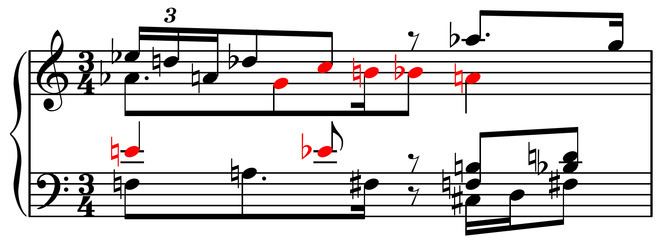 | ||
Sechs kleine Klavierstücke, Op. 19 (or Six Little Piano Pieces) is a set of pieces for solo piano written by the Austrian composer Arnold Schoenberg, published in 1913.
Contents
History
After having written large, dense works such as Pelleas und Melisande, up until 1907, Schönberg decided to turn away from this style, beginning with his second string quartet of 1908. The following excerpt, translated from a letter written to Ferruccio Busoni in 1909, well expresses his reaction against the excess of the Romantic period:
This work was composed at the same time that Schoenberg was working on his orchestration of his massive Gurre-Lieder. While he maintained a lifelong love of Romantic music, the extreme contrast between his Klavierstücke and his more romantic works comes from his modernist desire to find a new means of expression. For him, works like the Gurre-Lieder or Verklärte Nacht fulfilled the tradition he loved, but it was works like these Klavierstücke, or the Fünf Orchesterstücke that attempted to reach beyond it.
The first five pieces were written in a single day, February 19, 1911, and were originally intended to comprise the entire piece. Schoenberg penned the sixth piece on June 17, shortly after the death of Gustav Mahler. Indeed, it is a, "well circulated claim that Schoenberg conceived op. 19/vi as a tombeau to Mahler". It was first performed on February 4, 1912, in Berlin, by Louis Closson.
Structure
Each of the six pieces is aphoristically short, and unique in character. Following the expressionist aesthetic, each piece can be understood to be a long composition condensed into a single brief miniature. Schoenberg regarded this style of writing as a necessary compositional reaction to the diminishing power of tonality and this compositional style would be a huge influence on Schoenberg's pupil, Anton Webern, whose works are well known for their brevity. The work is commonly described as atonal, or at least any resemblance to tonality is fleeting, but it predates Schoenberg's later dodecaphonic development. The six pieces do not carry individual names, but are often known by their tempo marking:
- Leicht, zart (Light, delicate)
- Langsam (Slow)
- Sehr langsame (Very slow s)
- Rasch, aber leicht (Brisk, but light)
- Etwas rasch (Somewhat brisk)
- Sehr langsam (Very slow)
